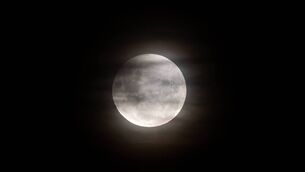Waiting for return of the ospreys
Her safe return is a relief; big birds are easy targets for trigger-happy gunmen on both sides of the Mediterranean. There’s no sign of her mate and she’s said to have taken a lover.
If she lived in Ireland Lady would be entitled to the free travel pass; this will be her 22nd breeding season. Ospreys can live for up to 32 years, but few see their 10th birthday. She has raised almost 50 chicks.
The wildlife filmmaker’s favourite bird patrols lakes and coastal lagoons, seeking fish swimming close to the water surface. The osprey dives, wings half spread, towards its victim. About to strike, the talons are thrown forward. Impact causes the legs to fold, sinking the lethal claws in the victim’s body. The talons lock automatically. The fish is lifted into the air, taken to a perch, and eaten.
Ospreys, seen as a threat to fish stocks, were persecuted to extinction in Britain. Breeding ceased in 1919. Then, in 1954, a pair nested on Loch Garten in the Highlands. Soon, other sites were occupied and a slow recovery began. Egg collectors were a major threat so the nest locations were kept secret. Eyries were guarded around the clock.
In 1959, the Royal Society for the Protection of Birds took a bold step; they ‘went public’ with the Loch Garten nest. An observation hide was provided and the public were invited to come and see the birds. The ospreys became famous and goodwill towards them soared. More than two million people have visited the site over the years. By 1980 there were 26 pairs of ospreys in Scotland. At the turn of the millennium, the number had reached 136. There are between 250 and 300 pairs now.
Rutland Water, in the English midlands, is one of Europe’s largest reservoirs. Over a six-year period, chicks were moved there from nests in Scotland. In 1999, some of the birds returned to Rutland from Africa and, in 2001, a pair nested. Another pair bred that year in the Lake District.
Next it was Wales’ turn to be re-colonised. In 2004, a nest in a dead tree at Portmadoc collapsed. Schoolchildren helped construct a nesting platform and the pair bred successfully the following year.
With ospreys breeding again in Scotland, England and Wales, Ireland is the odd man out. Birds, from Scotland and Scandinavia, pass through on their journeys to and from Africa, but there’s no direct evidence of nesting here. It’s almost certain, however, that ospreys did so in the past. Gordon Darcy in Ireland’s Lost Birds notes that bones from two individuals were found during excavations at Fishamble Street in Dublin. They were dated to the 10th or 11th Centuries; were ospreys persecuted by Medieval game-keepers protecting fish stocks in the Liffey? Gerald of Wales, who visited Ireland twice in the 12th Century, describes the bird, but some of his other claims are so outlandish that nothing he says can be believed. A description in a manuscript attributed to the 17th Century naturalist William Molyneux is more reliable. Darcy claims that the illustration of an eagle, representing St. John in the Book of Armagh, looks suspiciously like an osprey. There is a reference in Irish to a bird of prey catching salmon in its talons and some Irish bird names seem to refer to ospreys. The Irish Rare Breeding Birds Panel lists the species as an ‘anticipated’ or ‘possible-probable’ nester. Their most recent report, which covers 2010, lists three sightings for ospreys between May and August.
Nineteen records, involving about 11 birds, appear on the Irish Birding website for the same year. So, will the bird return to Ireland of its own accord? Should we build platforms at suitable locations to encourage them? Would the Scots give us some of their chicks? Now that our introduced red kites are breeding well, golden eagles have nested and white-tailed ones are holding territory, ospreys re-colonising would be the icing on the cake. Come back, fish eating hawk, all is forgiven.











